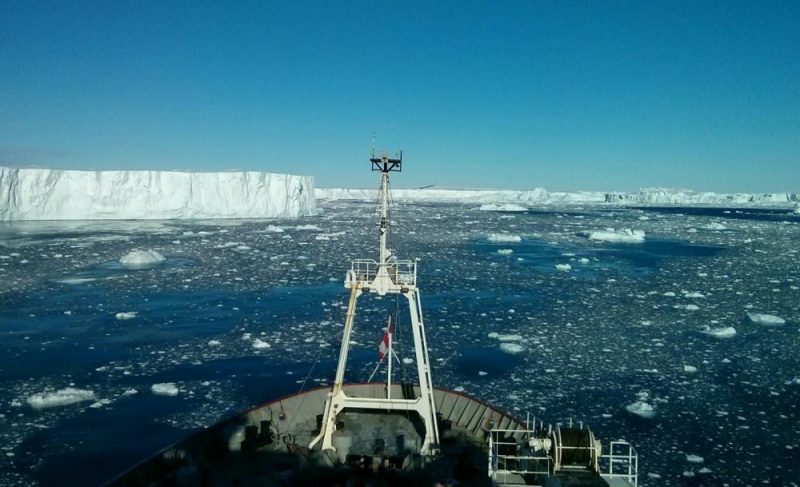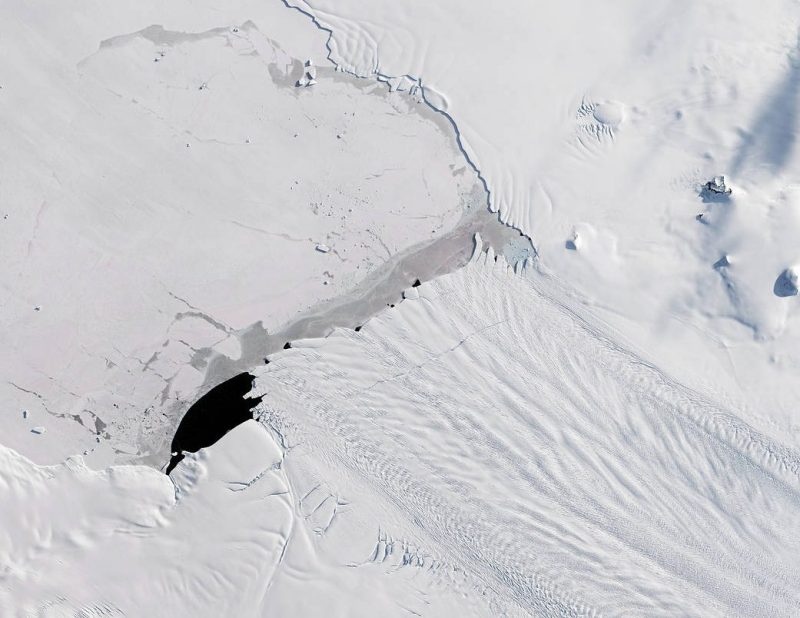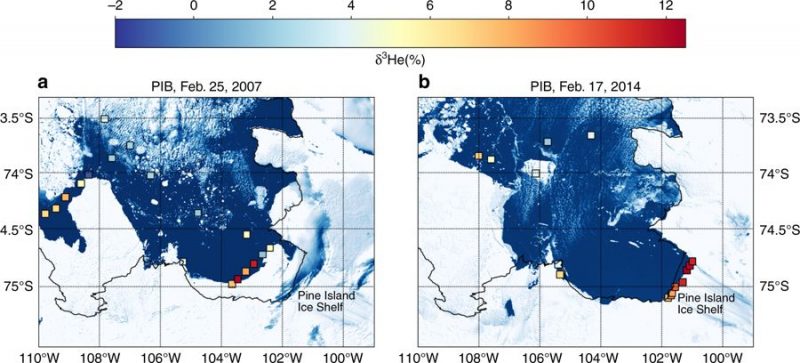
This article is republished with permission from GlacierHub. This post was written by Andrew Angle.
West Antarctica’s Pine Island Glacier (PIG) is the fastest-melting glacier in Antarctica, making it the single biggest contributor to global sea-level rise. The main driver of this rapid loss of ice is the thinning of the PIG from below by warming ocean waters due to climate change. However, a study, published June 22, 2018, in Nature Communications, discovered a volcanic heat source beneath the PIG that is another possible driver of the PIG’s melting.

Study lead author Brice Loose spoke to GlacierHub about the research. He said that the study was a result of a larger project funded by the National Science Foundation and the U.K. National Environmental Research Council to
… examine the stability of the Pine Island Glacier from the terrestrial and the ocean side.
The West Antarctic Ice Sheet (WAIS), which includes the PIG, sits on top of the West Antarctic Rift System that includes 138 known volcanoes. It is difficult, however, for scientists to pinpoint the exact location of these volcanoes or the extent of the rift system, because most of the volcanic activity occurs below kilometers of ice.

Warming ocean temperatures due to climate change have long been identified as the primary contributor to the extensive melting of the PIG and other glaciers that transport ice from the WAIS. This melting is largely driven by Circumpolar Deep Water (CDW), which melts the PIG from below and leads to the retreat of its grounding line, the place where the ice meets the bedrock.
To trace CDW around coastal Antarctica, the scientists used helium isotopes, specifically He-3, because CDW is widely recognized as the principal source of He-3 in the waters near the continent. For this study, the scientists used historical data of helium measurements from the Weddell, Ross and Amundsen seas around Antarctica. They looked at the three seas, all of which have CDW, and examined differences in He-3, which could have come from volcanic activity.
By tracing the glacial meltwater produced by the CDW, the researchers discovered a volcanic signal that stood out in their data. The helium measurements utilized were expressed by the percent deviation of the observed data from the atmospheric ratio. For the observed CDW in the Weddell Sea, this deviation was 10.2 percent. In the Ross and Amundsen Seas, it was 10.9 percent. However, HE-3 values gathered by the team during expeditions to the Pine Island Bay in 2007 and 2014 differed from the historical data.

For this data, the percent deviation was considerably higher at 12.3 percent, with the highest values being near the strongest meltwater outflow from the PIG’s front. Additionally, these high helium values coincided with raised neon concentrations, which are usually an indication of melted glacial ice. The helium was also not uniformly distributed. This suggests it originated from a distinct meltwater source and not from across the PIG’s entire front.
With this knowledge in hand, the team of scientists endeavored to identify the source of the HE-3 production. The Earth’s mantle is the largest source of HE-3, although it is also produced in the atmosphere and during past atmospheric tests of nuclear weapons through tritium decay. These two sources, however, could only account for 0.2 percent of the 2014 data.
Another potential source was a fissure in the earth’s crust directly below the PIG, where He-3 could rise from the mantle. However, this source was ruled out as it would have a strong thermal signature, something that was not discovered by mapping expeditions.

The researchers then considered another source: a volcano beneath the PIG itself, where He-3 escapes from the mantle in a process known as magma degassing. The He-3 could be transported by glacial meltwater to the PIG’s grounding line, where the ice meets the underlying bedrock. At this line, the ice shifts due to the ocean tides, allowing the meltwater and the He-3 to be discharged into the ocean.
After identifying a subglacial volcano as the most likely source of the elevated He-3 levels near the PIG’s front, the scientists next calculated the heat released by the volcano in joules per kilogram of sea water at the front of the glacier. It turned out that the heat given off by the volcano constitutes a very small fraction of the overall mass loss of the PIG compared to the CDW, according to Loose.
In total, the volcanic heat was 32 ± 12 joules kg-1, while the heat content of the CDW was much larger at 12 kilojoules kg-1. Nevertheless, if the volcanic heat is intermittent and/or concentrated over a small surface area, it could still have an impact on the overall stability of the PIG by changing its subsurface conditions, said Loose. There is also the possibility that the continued melting of the PIG could lessen the pressure and weight on the volcano, spurring more volcanism and subsequent melting.
The presence of an active volcanic heat source beneath the world’s fastest-melting glacier is a disturbing discovery that threatens to accelerate the PIG’s contribution to future sea-level rise. To develop a better understanding of how the volcano might impact the PIG, Loose stated that future studies should examine how the volcanic signal varies from year to year and attempt to pinpoint the likely location of the volcano itself beneath the ice.
Bottom line: A recent study discovered a volcano beneath Antarctica’s Pine Island Glacier.











